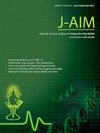Electroencephalogram analysis on alpha/beta and theta/beta ratios due to shirodhara
IF 1.9
Q3 INTEGRATIVE & COMPLEMENTARY MEDICINE
引用次数: 0
Abstract
Background
Shirodhara is a brain relaxation therapy. The treatment induces a relaxed state with awareness that results in treating neurological conditions like mental stress (depression/anxiety/hypertension) and some of its beneficial side effects are soothing the central nervous system.
Objectives
In the present study, the investigation aimed to analyze the ratios of brain waves, particularly focusing on the frontal region.
Materials and Methods
In this study, Shirodhara with “Ksheerabala thailam” medicinal oil was conducted on 16 participants and pre-post treatment brain signals were collected using an EEG acquisition tool and it was found that treatment induced relaxation aspects were observed among participants.
Results and Conclusion
Welch's Fast Fourier transform (FFT) was used to analyze the EEG signals in order to obtain power spectral density (PSD) features, which indicated a signal's power dispersed across a range of frequencies. The effectiveness of treatment has been evaluated by examining the spectral power ratios of alpha/beta, theta/beta in the frontal region of the brain and physiological and psychological parameters.
shirodhara引起的α / β和θ / β比值的脑电图分析
shirodhara是一种大脑放松疗法。这种疗法通过有意识地诱导一种放松状态,从而治疗神经系统疾病,如精神压力(抑郁/焦虑/高血压),其一些有益的副作用是舒缓中枢神经系统。目的在本研究中,调查旨在分析脑电波的比例,特别是在额叶区域。材料与方法本研究对16名被试进行了“泰国香薷”药油施洛治疗,并利用脑电图采集工具采集了治疗前后的脑信号,发现被试存在治疗诱导的放松方面。结果与结论采用快速傅里叶变换(FFT)对脑电信号进行分析,得到功率谱密度(PSD)特征,该特征表征了信号在一定频率范围内的功率分布。通过检查大脑额叶区α / β、θ / β的频谱功率比以及生理和心理参数,评估了治疗的有效性。
本文章由计算机程序翻译,如有差异,请以英文原文为准。
求助全文
约1分钟内获得全文
求助全文
来源期刊

Journal of Ayurveda and Integrative Medicine
INTEGRATIVE & COMPLEMENTARY MEDICINE-
CiteScore
4.70
自引率
12.50%
发文量
136
审稿时长
30 weeks
 求助内容:
求助内容: 应助结果提醒方式:
应助结果提醒方式:


